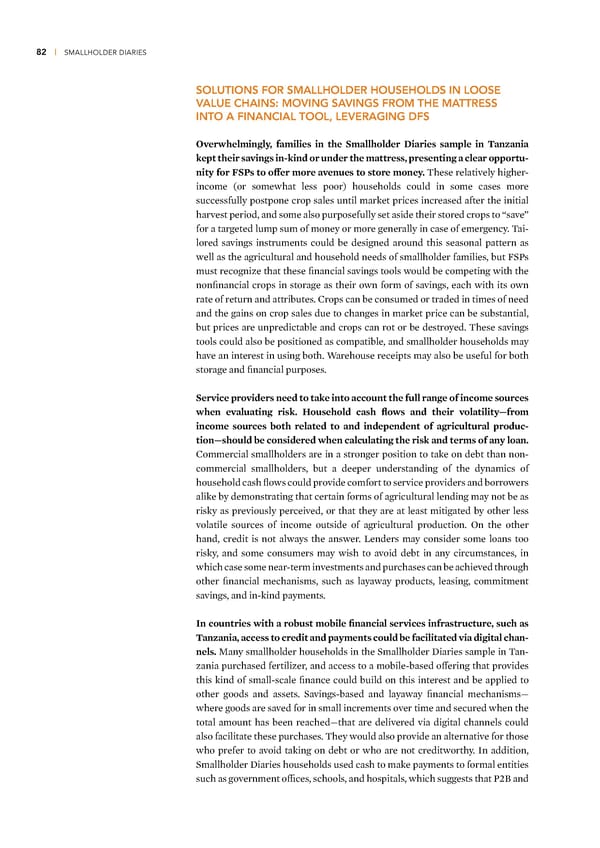82 | SMALLHOLDER DIARIES SOLUTIONS FOR SMALLHOLDER HOUSEHOLDS IN LOOSE VALUE CHAINS: MOVING SAVINGS FROM THE MATTRESS INTO A FINANCIAL TOOL, LEVERAGING DFS –erwhelmingly, families in the Smallholder Diaries sample in anania ƒept their saings in-ƒind or under the mattress, presenting a clear opportu- nity for FS‚s to offer more aenues to store money Œhese relatively higher- income (or somewhat less poor) households could in some cases more successfully postpone crop sales until maret prices increased after the initial harvest period, and some also purposefully set aside their stored crops to “save” for a targeted lump sum of money or more generally in case of emergency Œai- lored savings instruments could be designed around this seasonal pattern as well as the agricultural and household needs of smallholder families, but Ss must recogni—e that these financial savings tools would be competing with the nonfinancial crops in storage as their own form of savings, each with its own rate of return and attributes †rops can be consumed or traded in times of need and the gains on crop sales due to changes in maret price can be substantial, but prices are unpredictable and crops can rot or be destroyed Œhese savings tools could also be positioned as compatible, and smallholder households may have an interest in using both ™arehouse receipts may also be useful for both storage and financial purposes Serice proiders need to taƒe into account the full range of income sources when ealuating risƒ ›ousehold cash flows and their olatility—from income sources both related to and independent of agricultural produc- tion—should be considered when calculating the risƒ and terms of any loan †ommercial smallholders are in a stronger position to tae on debt than non- commercial smallholders, but a deeper understanding of the dynamics of household cash flows could provide comfort to service providers and borrowers alie by demonstrating that certain forms of agricultural lending may not be as risy as previously perceived, or that they are at least mitigated by other less volatile sources of income outside of agricultural production ¦n the other hand, credit is not always the answer ƒenders may consider some loans too risy, and some consumers may wish to avoid debt in any circumstances, in which case some near-term investments and purchases can be achieved through other financial mechanisms, such as layaway products, leasing, commitment savings, and in-ind payments Šn countries with a robust mobile financial serices infrastructure, such as anania, access to credit and payments could be facilitated ia digital chan- nels –any smallholder households in the Smallholder ‰iaries sample in Œan- —ania purchased fertili—er, and access to a mobile-based offering that provides this ind of small-scale finance could build on this interest and be applied to other goods and assets Savings-based and layaway financial mechanisms— where goods are saved for in small increments over time and secured when the total amount has been reached—that are delivered via digital channels could also facilitate these purchases Œhey would also provide an alternative for those who prefer to avoid taing on debt or who are not creditworthy €n addition, Smallholder ‰iaries households used cash to mae payments to formal entities such as government offices, schools, and hospitals, which suggests that ‘£ and
 Financial Diaries with Smallholder Families Page 100 Page 102
Financial Diaries with Smallholder Families Page 100 Page 102